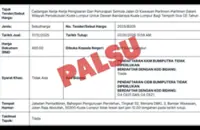A group feeding the homeless in front of a sign that prohibits food distribution in the area.
“We cannot cope, there is just too much rubbish all the time,” says a tired Alam Flora worker who has been cleaning the historic area in Lebuh Pudu, Kuala Lumpur.
This cleaner, who did not want to be named, was referring to the excessive amount of rubbish thrown by the homeless community either living or loitering in the area in search of food and handouts.
Already a subscriber? Log in
Save 30% OFF The Star Digital Access
Cancel anytime. Ad-free. Unlimited access with perks.





